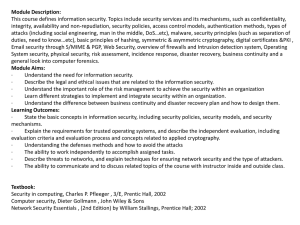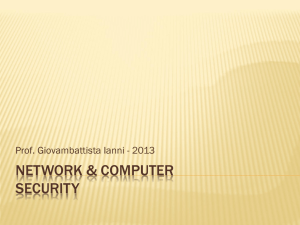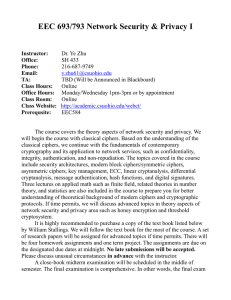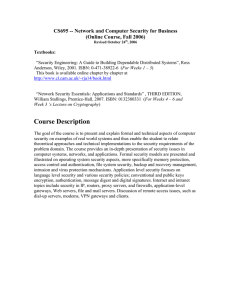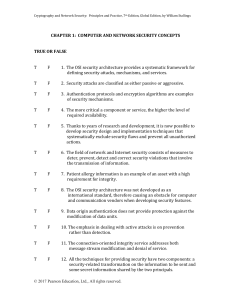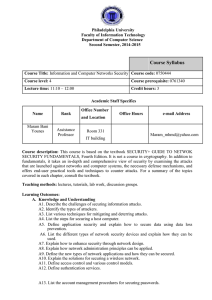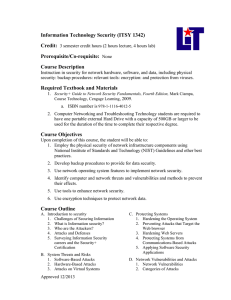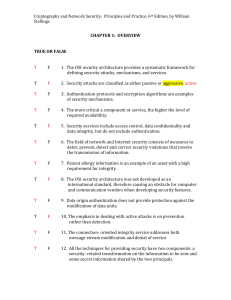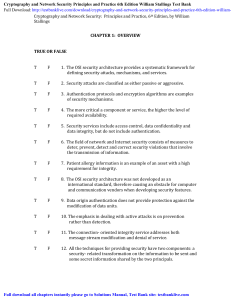CEN448 - Introduction
advertisement
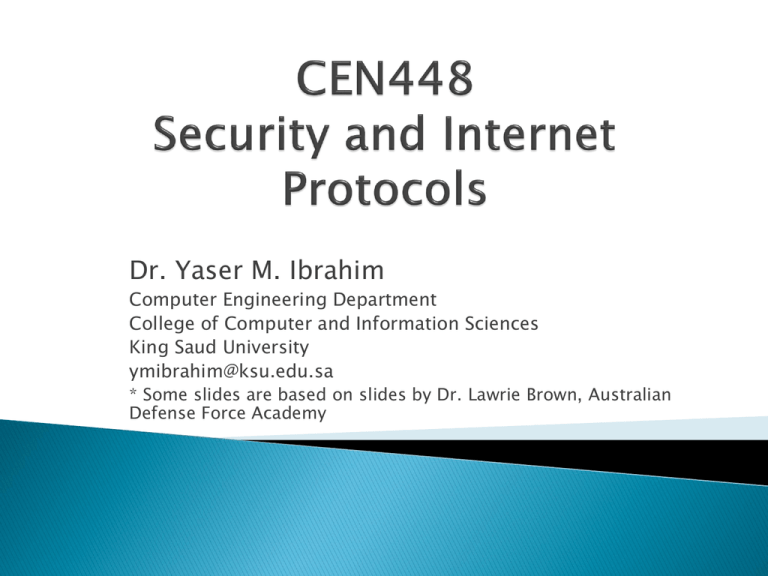
Dr. Yaser M. Ibrahim Computer Engineering Department College of Computer and Information Sciences King Saud University ymibrahim@ksu.edu.sa * Some slides are based on slides by Dr. Lawrie Brown, Australian Defense Force Academy Dr. Yaser Ibrahim Email: ymibrahim@ksu.edu.sa Office: CCIS (Bldg. 31) - Room 2188 Tel. : 01-4695208 Office Hours: Sun. 8 to 9 AM Mon. 8 to10 AM Wed. 8 to 10 AM TA: ?? 2 Overview, Security Concepts, Attacks, Services; Block Ciphers; Block Cipher Operation; PublicKey Cryptography and RSA; Cryptographic Hash Functions; User Authentication Protocols; Transport-Level Security; Wireless Network Security; IP Security; Intruders; Malicious Software; Firewalls Prerequisites : CEN 445 - Computer Networks 3 Textbook “Cryptography and Network Security” • William Stallings, 5th Ed., Prentice Hall References “Security Engineering: A Guide to Building Dependable Distributed Systems” • Ross Anderson, 2nd Ed., Wiley (1st edition and a few chapters of 2nd edition are available online at: http://www.cl.cam.ac.uk/~rja14/book.html) “Handbook of Applied Cryptography” • Alfred Menezes, Paul van Oorschot and Scott Vanstone, CRC Press (available online at: http://www.cacr.math.uwaterloo.ca/hac/) Handouts and the Web • Links to many resources will be provided 4 Final Exam: 40% Mid-term Exam #1: 20% On 22/11/1433 (Oct. 8, 2012) Mid-term Exam #2: 20% On 12/1/1434 (Nov. 26, 2012) Assignments & Quizzes: 20% Assignments are mini-projects Quizzes: every couple of weeks Practice problems from the book will be assigned but won’t have any credit 5 Questions and participation during class are highly encouraged. Cooperation and discussions between students are encouraged However, copying someone else’s work is not acceptable. Email will be used to communicate important information to students. Please make sure to update your email address on the KSU system. Students are responsible for observing the university calendar Class drop and withdrawal dates and any other important dates. 6 Attendance is mandatory Exceeding 25% absence rate will mean denial from final exam Excuses for absences are accepted only within 1 week of the absence Please be aware that plagiarism and cheating will not be tolerated Will lead to failing the course There will not be make-up for missed assignments and quizzes Don’t ask me to help you regarding your grade, please! I will not do that. 7 Network Security Concepts: Attacks, Mechanisms, Services Symmetric (Secret-Key) Cryptography Classical Encryption Techniques Modern Block Ciphers: DES, AES Asymmetric (Public-Key) Cryptography Message Authentication: Hash, MAC, Signatures User Authentication Network Attacks and Defenses Transport-level, IP, and wireless security Malware, Intruders, and Firewalls 8 Reading Assignment Read Ch. 1 from Stallings textbook Definition according to NIST “The protection afforded to an automated information system in order to attain the applicable objectives of preserving the integrity, availability and confidentiality of information system resources (includes hardware, software, firmware, information/data, and telecommunications)” not simple must consider potential attacks procedures used counter-intuitive involve algorithms and secret info must decide where to deploy mechanisms battle of wits between attacker / admin not perceived on benefit until fails requires regular monitoring too often an after-thought regarded as impediment to using system Security attack Any action that compromises the security of information owned by an organization Attack vs. threat Security mechanism Security service A process (or a device) that is designed to detect, prevent, or recover from a security attack E. g. encryption A service that enhances the security of the data processing/transfer systems Uses security mechanisms E. g. digital signature Authentication - assurance that communicating entity is the one claimed Access Control - prevention of the unauthorized use of a resource Data Confidentiality –protection of data from unauthorized disclosure Data Integrity - assurance that data received is as sent by an authorized entity Non-Repudiation - protection against denial by one of the parties in a communication Availability – resource accessible/usable feature designed to detect, prevent, or recover from a security attack no single mechanism that will support all services required however one particular element underlies many of the security mechanisms in use: cryptographic techniques hence our focus on this topic
